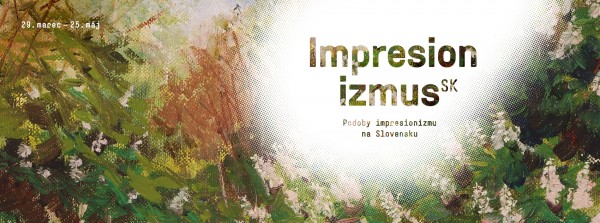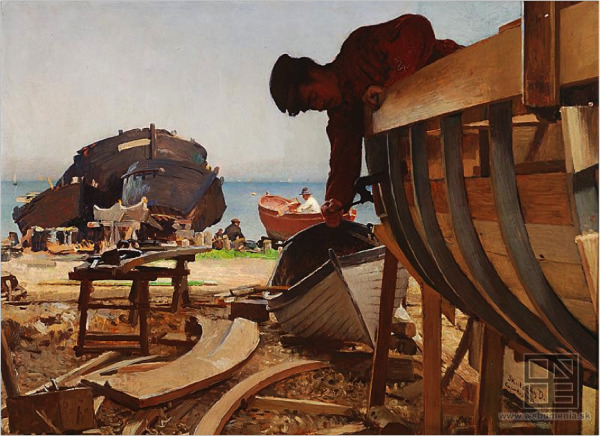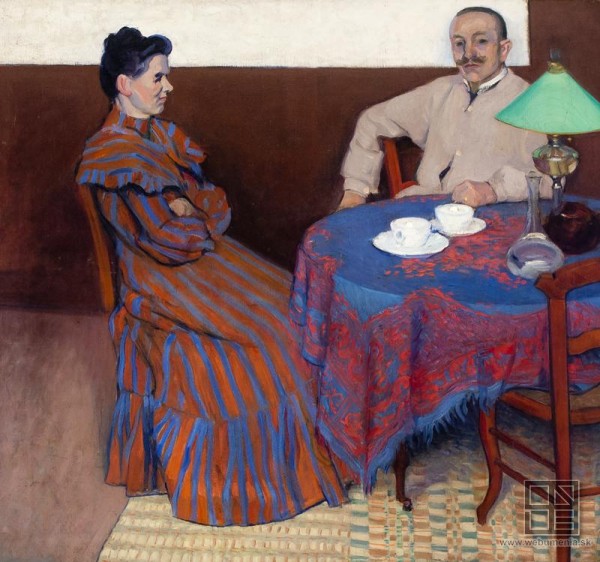When Marian Váross prepared the publication of the only Slovak monograph of Vincent van Gogh at the beginning of the 1960s, he couldn’t help but feel that his contribution to the theme of the great artist would only be a drop in the ocean.
Today, fifty years later, we are facing a similar situation when writing about Impressionism, the genre that sets attendance records at museum and gallery exhibitions and turns books into bestsellers. Virtually every large and small art museum in the world has presented a spectacular Impressionism exhibition: impressionists and fashion, impressionists and water, impressionists and snow, the masterpieces of Impressionism and others. In short, all of Europe has reacted to and continues to react to one of the first modern –isms. However, the general public in Slovakia has not had many opportunities to see for themselves that Impressionism is more than nice calendars and kitsch posters. The experience of seeing the original paintings of the French masters of the second half of the 19th century is certainly edifying, but even more edifying is the realization that painters who knew Monet, Pissaro, Boudin and Renoir, worked with them and frequently as well and interestingly as they did, lived and worked in Slovakia. As a result, the fear of adding drops to the ocean disappears not only in an effort to demonstrate the transformations of global art on our artists, but also in an effort to view Impressionism not as it was formed and spread from its center to the periphery, but on the contrary, how it was perceived by the periphery and what the periphery was able to learn from it. This reversed view is extremely important as a form of self-criticism and as an acknowledgement of the authenticity which in our circumstances is a mixture of diversity and tradition.
Impressionism in Slovakia is a phenomenon which, although not always referred to and fully clarified under this name, is continuously present in our art historical literature from the first attempts to synthetize Slovak art history. However, as opposed to previous historical periods, in the 19th century something broke, and for this we can be grateful; because it led to the origin of Slovak art defined by the nationality of the artist and not the territory on which he lived. Until this point, art in Slovakia comprised a relatively homogenous whole with the events in the country under the crown of Saint Stephen. Baroque and Renaissance were adopted later in our territory and in a significantly reduced form in comparison with their epicenters, where the styles took shape. However, this reduced feature, typical especially in terms of the formal aspect, is compensated for by cultural phenomena such as mercenarism, humanist learning and Baroque mysticism, and reflected in fine art.
It is within this context that the art of the end of the century before last makes an impression as something incomplete, disqualified in comparison with the previous ones. The cultural, spiritual connection of the events in the territory of present-day Slovakia with the Hungarian whole splits in the 19th century, and thus a new subset – Slovak art, emerged from a cultural province, in which it has to be said lacked a broader cultural anchoring and support from the intelligentsia. If we take a brief detour and look at the share of “Slovakness” in artistic expressions starting with the first waves of the Slovak national revival, fine art figures at the bottom of the chart. This situation, which was also characteristic for the reception of modern ideas in the world, caused greater susceptibility of a literary kind to changes which took place in the social system. In fact, Slovak literature of the 19th century stands alone – unaccompanied by significant Slovak paintings or sculpture.
Recent publications tell us that Slovak art at that time did not comprise an integrated whole. On the contrary, it was an incoherent complex of issues represented by artists with different national feelings, those representing the nation in various ways (if at all) and those creating in a particular way. In brief, our “Impressionism” must be perceived in segments and to add to its picture, those factors which albeit indirectly create its form today. Allow me to accent the problem which was already resolved years ago in the revolutionary publication Výtvarná moderna Slovenska (Fine Art Modernism of Slovakia) by Ján Abelovský and Katarína Bajcurová, who “did not find their role in the classification of the Slovak and non-Slovak, but on the contrary, in the historiographical appropriation of the heritage of artists, who by their national origin were not Slovaks, but who in some way were actively related to the modern cultural history, politics and social life of Slovakia from 1890 to 1949.”
Art is not an “invention” that spreads out in the world in a patented and standard form. Neither Impressionism nor its achievements arrived here as a package of tested skills. If this were true, perhaps it would have positively affected further development and spared many artists from mistakes and oblivion; however, that would have deprived us of the spice of originality. Central European painters underwent just what the key figures of this style underwent in the 1860s and 1870s. In France, the changes were pushed through in groups and gradually on the way to a new forming of opinion regarding the seen and the world. In our environment, this came about individually; and especially by the end of the 19th century and in the first half of the 20th century the models were borrowed, without previous experiment or resignation to tradition. However, the vision of the development and the effort to create something new was obvious. Everything was happening later and in a time of great transformation. As a result, the efforts of the upcoming periods covered up our art before it could reach its full flowering. This is also perhaps a reason to be thankful; as opposed to other countries, although our art history lacks an orthodox impressionist, we have quite a variety of forms of Impressionism in painting. In a certain sense, Impressionism became the basis of one strand of Slovak interwar art. It did not represent the starting point for avant-gardes, as in France or even in present-day Hungary, rather it became their alternative in the painting of the first half of the 20th century.
Slovak art of the end of the 19th century and the beginning of the 20th century was the result of a specific, slightly bizarre coincidence. Starting with national self-awareness, through the movements in social hierarchy up to artists’ sojourns to various corners of Europe, all this created a special heterogeneous structure, by which we can follow a work with individual means of expression that comes to terms with tradition and changes in the function of art. Therefore, this exhibition is divided into thematic units which demonstrate how the impressionistic style of painting caught on in our environment. Traces of the past and its strong bonds today represent an introduction to the the origin of modern art which crystalized in the form of Impressionism, thanks to the departure of painters to the countryside to rural artists’ colonies and en plein air painting. Its character already directly indicated a different method of working with color, light and space.



